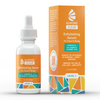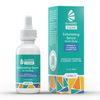About Butt Acne & Folliculitis

Almond Clear before and after photos clockwise from upper left: before treatement / week 2 / week 7/ month 5
Most red bumps on the butt are caused by acne, folliculitis, or a combination of both. These pimple-like bumps can range from small, red spots and blackheads to large, painful cysts that leave behind dark scars.
ACNE on the buttocks occurs when pores get clogged with a mixture of dead skin cells and sebum, the body’s natural oil. The plugs expand as more skin cells and oil build up, becoming whiteheads or blackheads. If pores get infected with bacteria, then swollen, red bumps form, and these bumps can even turn into painful cysts that leave lasting scars. Acne on the buttocks is made worse by the constant friction that occurs in this area and is also aggravated by sweat that's trapped between underwear and the skin.
FOLLICULITIS is sort of like acne, but it's a problem of the hair follicles, not the pores. Folliculitis occurs when hair follicles are infected with either bacteria or fungi, and this is more likely to happen in follicles that have been blocked by dead skin cells and oil. Folliculitis usually looks like many small, red bumps that are often topped by a whitehead. These bumps sometimes turn into large carbuncles that resemble acne cysts. The same culprits that inflame buttocks acne, constant friction and trapped sweat, are also responsible for flaring up folliculitis on the rear end.
It can be hard to tell the difference between acne and folliculitis, and it’s common for people to have both. Luckily, a precise diagnosis isn’t necessary because both problems can be successfully tackled using the same products and self-care tips.
Treatment

Before & after 5 months- Almond Clear Level 2
Whether your butt is breaking out with acne, folliculitis, or both, you need a product that is exfoliating, antibacterial and antifungal, and that fades scars. Alpha hydroxy acids (AHAs) like salicylic and glycolic are good choices, but the best option is mandelic acid, an alpha hydroxy acid that is derived from bitter almonds. The following properties make mandelic acid a clear winner for treating booty breakouts:
- ANTIBACTERIAL & ANTIFUNGAL: Mandelic acid has strong antibacterial and antifungal properties, so it fights the invaders that cause both acne and folliculitis to flare up. Other skin care acids are antibacterial, but mandelic acid is the only one that's both antibacterial and antifungal, making it ideal to treat both acne and folliculitis.
- EXFOLIATING: Mandelic acid dissolves the bonds between skin cells, and this allows dead skin cells trapped in the pores and hair follicles to be flushed away. Once this congested material is cleared, the pore or follicle can function normally. Both acne and folliculitis are greatly aggravated by dead skin cell build ups.
- SAFE FOR ALL SKIN TYPES: Mandelic acid is the most gentle alpha hydroxy acid treatment. It has a larger molecular size than other acids, and these larger molecules are slower to absorb into the skin. Other acids, like glycolic and salicylic, can be very drying and irritating. Mandelic acid can be safely used for all skin tones, from very light to very dark, and it won’t cause hyperpigmentation (dark spots) or reddening like other skincare products.
Butt acne self-care tips

To reduce butt acne, make sure to shower right after exercising
To avoid future breakouts, regularly apply a serum that contains mandelic acid, and follow these tips:
- Shower as soon as possible after exercising. Leaving perspiration close to your body will seriously exacerbate breakouts.
- Wear breathable clothing and underwear whenever possible. Cotton and other natural fibers are the best choices. Avoid synthetic fibers like satin and polyester because they trap moisture and don't allow your skin to breathe.
- Change out of your skinny jeans every once in a while. Tight pants create friction and trap sweat and bacteria against your skin. Try changing into more breathable pants once you get home in the evening.
- Make sure to wash your bedding regularly. Dirt and oil trapped on sheets will rub against your skin all night and contribute to breakouts.
- Don’t scrub too hard in the shower. This will irritate your skin, cause further redness and swelling, and can cause bacteria or fungus to spread. Instead of harsh scrubbing, use a clean washcloth and gently rub the area using circular motions.


